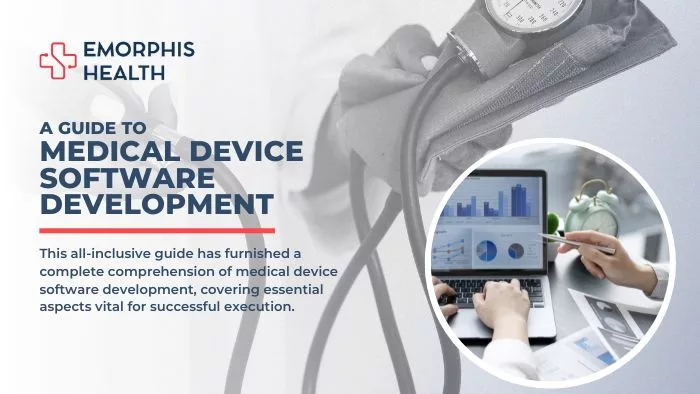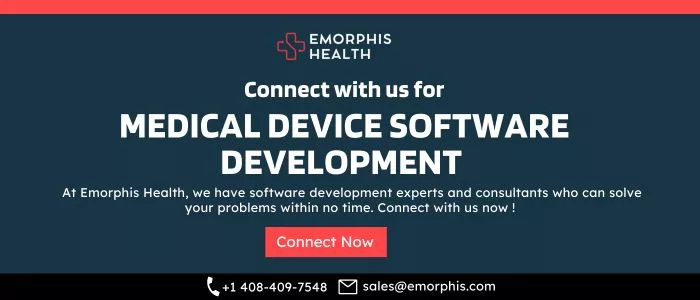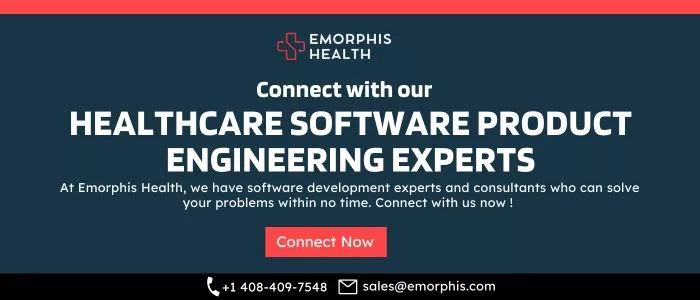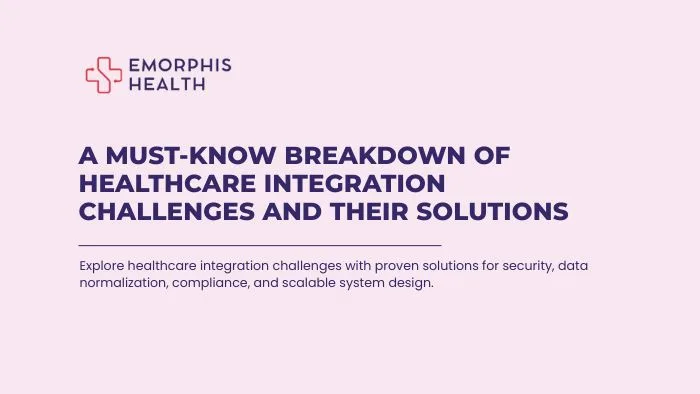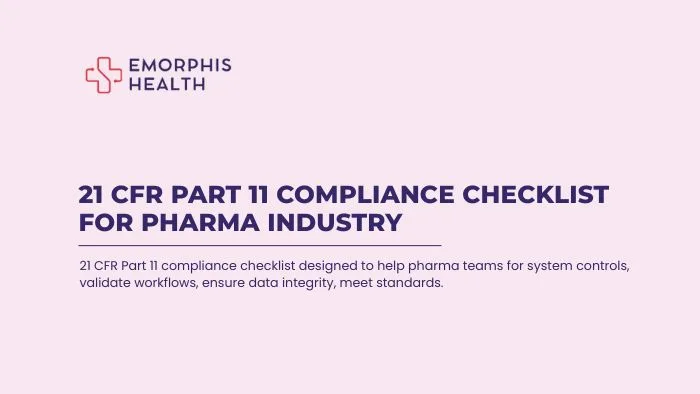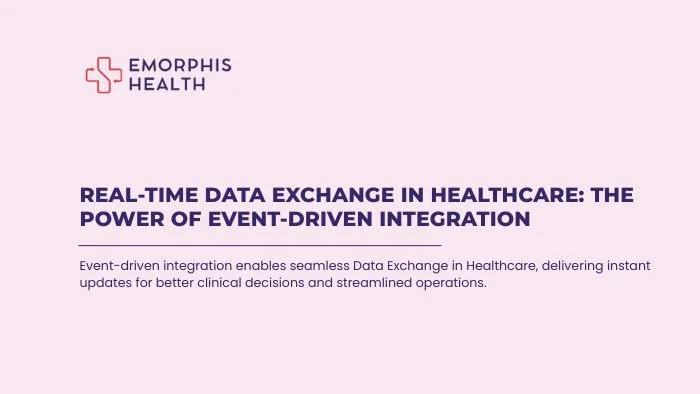The Evolution of Medical Device Software: From Standalone to Connected Systems
See Contents
- 1 The Evolution of Medical Device Software: From Standalone to Connected Systems
- 2 Types of Medical Device Software Development
- 3 Market Size and Key Factors Driving Medical device software development Growth
- 4 Medical Device Software Development Process
- 5 Popular Tech Stack for Medical Device Software Development
- 6 Important Points with Medical Device Software Development
- 7 Top 16 Popular Medical Device Software Solutions
- 8 Future of Medical Device Software Development
- 9 Cost Factors of Medical Device Software Development
- 10 Conclusion
Medical devices have come a long way in how they use software to improve patient care. In the past, medical devices were standalone tools designed to perform specific tasks, such as measuring blood pressure or monitoring heart rate. While these devices were helpful, they operated independently and didn’t communicate with each other or with healthcare networks. Today, medical device software development has evolved into interconnected systems that work together seamlessly. These connected systems integrate with other devices and healthcare networks, bringing numerous benefits to patient care and data management.
Imagine a scenario where a patient’s wearable fitness tracker communicates with their smartphone app, which, in turn, shares health data with their doctor’s electronic health record (EHR) system. This interconnectedness allows healthcare professionals to have a more comprehensive view of the patient’s health and make better-informed decisions.
Connected medical device software also enables remote monitoring and telemedicine, where doctors can monitor patients’ health conditions from a distance and provide timely advice and interventions. Patients can enjoy more personalized care and actively participate in managing their health.
As the medical industry continues to embrace technological advancements, we can expect further improvements in medical device software development, making healthcare more efficient, accessible, and patient-centric than ever before.
Let us find out what are the types of medical device software solutions.
Types of Medical Device Software Development
As a matter of fact, medical device software development encompasses various types of software solutions that play critical roles in supporting medical devices and healthcare systems. Also, it is important to note that these software types cater to different aspects of the healthcare industry, facilitating enhanced patient care and operational efficiency.
In fact, one of the prominent types is Embedded Software, which is integrated directly into medical devices, enabling them to perform specific functions or control device operations. Additionally, Software as a Medical Device, SaMD solutions like Electronic Health Record (EHR) Software serve as a crucial tool in storing, managing, and accessing patient health information electronically, ensuring comprehensive and accessible patient records for healthcare providers.
Moreover, Medical Imaging and Diagnostic Software are essential for processing, analyzing, and interpreting medical images, aiding healthcare professionals in diagnosing and monitoring various medical conditions. Similarly, Telemedicine Software has gained prominence, allowing patients to connect with healthcare providers remotely, facilitating virtual appointments and remote monitoring for improved accessibility and convenience.
Furthermore, Healthcare Mobile Applications are becoming increasingly popular as they offer patient monitoring, medication reminders, fitness tracking, and easy access to medical information on the go. Clinical Decision Support Systems (CDSS) are also gaining importance, providing evidence-based medical knowledge and patient data analysis to aid healthcare professionals in making informed clinical decisions.
Lastly, Medical Practice Management Software streamlines administrative tasks, appointment scheduling, billing, and patient records management in healthcare facilities, contributing to more efficient operations.
Hence, we can state that the diverse range of medical device software types, including Embedded Software, SaMD solutions like EHR Software, Medical Imaging and Diagnostic Software, Telemedicine Software, Healthcare Mobile Applications, CDSS, and Medical Practice Management Software, collectively enhance patient care, improve healthcare workflows, and also support the ever-evolving landscape of the healthcare industry.
What is Software as a Medical Device?
Software as a Medical Device (SaMD) has emerged as a significant and transformative aspect of the healthcare industry. As a matter of fact, SaMD refers to software applications specifically intended to be used for medical purposes without being part of a hardware medical device. This distinction allows Software as a Medical Device to function independently and provides numerous advantages in the medical field.
The growth and adoption of SaMD have been driven by several key factors.
Firstly, its inherent flexibility and accessibility enable healthcare professionals to use it across various platforms, such as smartphones, tablets, and computers, making it convenient for both clinicians and patients. In fact, SaMD has revolutionized patient care by empowering individuals to monitor their health, access medical information, and even perform self-assessments remotely.
Another key factor propelling the growth of Software as a Medical Device is the speed of innovation. Unlike traditional medical devices that require lengthy and expensive hardware development cycles, SaMD can be rapidly updated and improved through software updates. This agility allows for continuous advancements and keeps the technology aligned with the latest medical knowledge and regulatory standards.
Moreover, SaMD has played a vital role in the growing trend of personalized medicine. With the ability to process vast amounts of patient data and provide real-time insights, Software as a Medical Device assists healthcare professionals in making precise and personalized treatment decisions, enhancing patient outcomes and treatment effectiveness.
Furthermore, Software as a Medical Device’s ability to integrate with other healthcare systems and medical devices fosters interoperability and data exchange, ultimately leading to a more comprehensive and interconnected healthcare ecosystem.
However, it is crucial to address challenges like data security, privacy, and regulatory compliance to ensure SaMD’s safe and ethical use. As Software as a Medical Device continues to evolve, stakeholders must collaborate to establish robust regulatory frameworks, safeguard patient information, and maintain the highest standards of safety and efficacy.
Let us now check statistics and driving forces for medical device software development.
Market Size and Key Factors Driving Medical device software development Growth
Now, let’s check about the exciting world of Software as a Medical Device (SaMD) and its market growth. According to a report by GlobeNewswire, the Global Software as a Medical Device Market Size was valued at a whopping USD 1048.00 million in 2021, and guess what? It’s projected to reach a staggering USD 10190.00 million by 2028, with a remarkable CAGR of 38.39% during the forecast period.
With technology continually evolving, the SaMD market holds immense potential for transformative healthcare solutions. As a matter of fact, the medical device software development market has experienced significant growth in recent years. The market size reaches substantial figures, driven by various key factors that contribute to its expansion and importance in the healthcare industry.
Key Growth Factors of Medical Device Software Development
One of the primary drivers of this growth is the increasing adoption of technology in healthcare. Medical device software solutions, such as Electronic Health Record (EHR) systems, telemedicine software, and diagnostic imaging software, are becoming integral components of modern healthcare practices. They enhance patient care, streamline workflows, and improve overall healthcare outcomes.
Additionally, the growing demand for cost-effective and efficient healthcare solutions has spurred the development and implementation of medical device software. These solutions enable healthcare providers to optimize their operations, reduce administrative burdens, and deliver quality care without compromising patient safety.
Furthermore, the emphasis on patient safety and regulatory compliance has propelled the need for standardized and well-documented software development processes. Adherence to international standards like IEC 62304 ensures that medical device software is developed with rigorous attention to quality and safety, further driving market growth.
Moreover, the rise in chronic diseases and the aging population has increased the demand for advanced medical devices and software solutions that can support better disease management and patient monitoring.
Lastly, ongoing technological advancements, such as the Internet of Things (IoT) and artificial intelligence (AI), are paving the way for innovative medical device software applications. These technologies offer new possibilities for remote patient monitoring, real-time data analysis, and personalized healthcare services.
Let’s now get into the details of the process of medical device software development.
Medical Device Software Development Process
Developing medical device software is a complex and important task that involves careful planning, following regulations, and focusing on safety and quality. Let’s go through a step-by-step guide to help you navigate the medical device software development process:
1. Understanding the Requirements
To start, you need to define what your medical device software will do and how it will be used. Conduct a thorough analysis of what users, like doctors and patients, need from the software. Also, identify any potential risks or safety concerns related to its use.
2. Regulatory Compliance
Familiarize yourself with the rules and regulations that apply to medical devices, such as those from the FDA or EU MDR. Depending on your software’s complexity, you’ll need to determine which regulatory pathway it falls under (Class I, II, or III). Plan how you will meet these regulatory requirements throughout the development process.
3. Software Development Lifecycle
Choose a structured development approach, like Agile or the V-model, that aligns with regulatory standards. Break the development process into different stages, each with specific tasks and milestones to achieve.
4. User-Centered Design
Involve the end-users, such as doctors and patients, in the design process. Listen to their needs and preferences to create an easy-to-use interface. Enhance the design by conducting usability testing and collecting user feedback.
5. Risk Management
Identify potential risks and hazards associated with the software and develop strategies to reduce or eliminate them. Implement a risk management process that lasts throughout the entire development journey.
6. Software Architecture
Plan the software’s structure and how its different components will work together. Ensure the software is scalable and can be easily updated and improved. Also, pay attention to data storage, security, and encryption to protect sensitive information.
7. Validation and Verification
Develop a comprehensive plan to test the software at different stages of development. Ensure the software meets all its intended requirements. Keep records of all the tests and link them back to the specific requirements they address.
8. Documentation and Traceability
Maintain detailed documentation of the development process. Make sure that everything is traceable, meaning that you can follow the link between requirements, design, testing, and risk management activities.
9. Interoperability and Connectivity
If your software needs to work with other medical devices or systems, design it to be interoperable. Test how it interacts with other relevant devices and standards.
10. Quality Management
Put in place a strong quality management system to ensure that your development practices are consistent and of high quality. Conduct internal audits to monitor compliance with quality procedures.
11. Post-Market Surveillance
After releasing the software, set up a plan to monitor its performance and gather user feedback. Use this data to identify and address any potential issues that may arise.
12. Training and Support
Develop training materials for users and provide guidance to support staff. Make sure that timely support is available to address any reported issues.
13. Change Control and Software Updates
Establish a process to manage software updates and version control. Consider how to notify users of changes and assess any potential risks associated with updates.
14. Risk-Benefit Analysis
Conduct an analysis to demonstrate that the benefits of the software outweigh any potential risks it may have.
Developing medical device software is a multidisciplinary task that requires collaboration among software engineers, medical professionals, regulatory experts, and quality assurance specialists. Always prioritize patient safety and compliance with regulations throughout the development journey to create software that positively impacts healthcare.
Popular Tech Stack for Medical Device Software Development
Now Let’s talk about the popular tech stack used for Medical Device Software Development, including both Embedded Software and Software as a Medical Device (SaMD).
For Embedded Software, which is integrated directly into medical devices, developers commonly use programming languages like C and C++. These languages are highly efficient and allow the software to run smoothly on the device’s hardware. Additionally, they provide better control over the device’s functionalities and ensure real-time responsiveness.
In fact, Embedded Software often utilizes Real-Time Operating Systems (RTOS) like FreeRTOS and VxWorks. These specialized operating systems are designed to manage tasks with strict timing requirements, making them perfect for medical devices that need to perform critical functions with minimal delay.
For Software as a Medical Device (SaMD), which functions independently of hardware devices, developers typically employ a wide range of technologies. Web technologies like HTML, CSS, and JavaScript are frequently used to create user-friendly and interactive interfaces for SaMD applications.
Furthermore, programming languages like Python, Java, and C# are common choices for SaMD development. Software as a Medical Device development offers flexibility and ease of use, allowing developers to create complex algorithms and data processing capabilities.
Cloud
Also, cloud computing services play a critical and indispensable role in the development of Software as a Medical Device (SaMD). The utilization of robust cloud platforms like AWS (Amazon Web Services), Azure (Microsoft Azure), or Google Cloud brings significant advantages to the SaMD industry, particularly concerning the secure and efficient management of vast amounts of medical data.
In the realm of SaMD development, the volume of medical data generated and processed can be substantial, encompassing patient health records, diagnostic images, real-time monitoring data, and more. This plethora of information demands powerful and scalable data storage solutions, and cloud computing provides just that. By leveraging cloud platforms, developers can access highly resilient and secure storage services, accommodating the extensive data generated by SaMD applications.
Moreover, cloud computing services offer exceptional processing capabilities, allowing SaMD developers to carry out complex computations and data analytics efficiently. The cloud’s elasticity ensures that computational resources can be dynamically adjusted to meet varying workloads, optimizing performance while minimizing costs.
Storage and Security are paramount in the healthcare industry, and SaMD is no exception.
Cloud providers invest heavily in robust security measures, including encryption, access controls, and compliance certifications like HIPAA (Health Insurance Portability and Accountability Act) and GDPR (General Data Protection Regulation). By entrusting their SaMD development to reputable cloud platforms, developers can enhance the protection of sensitive medical data and maintain compliance with stringent data privacy regulations.
The cloud’s accessibility is also a significant advantage for SaMD development. With cloud-based services, developers can collaborate seamlessly, regardless of their geographical locations. This fosters a collaborative and innovative development environment, encouraging cross-functional expertise to contribute to the SaMD’s success.
Additionally, cloud platforms offer reliable and redundant data backups, ensuring that medical data remains available and secure even in the face of unexpected events like hardware failures or disasters.
Further, check our detailed insights on Health Cloud Migration Services.
IoT
IoT (Internet of Things) plays a crucial role in both Embedded Software and Software as a Medical Device (SaMD) development for medical devices.
In fact, IoT integration has become increasingly significant in medical device software development. For Embedded Software, IoT enables seamless connectivity between medical devices and other systems, allowing data exchange and remote monitoring. IoT sensors embedded in medical devices can collect real-time patient data, which can be transmitted securely to healthcare providers for analysis and decision-making.
As a matter of fact, in SaMD applications, IoT technology enhances the functionality and capabilities of the software. IoT-enabled SaMD can interact with wearable devices and other smart devices to collect data and provide personalized health insights to users. This connectivity allows patients and healthcare professionals to monitor health conditions more effectively and make informed decisions about treatments.
Moreover, IoT-enabled SaMD can facilitate remote patient monitoring, telemedicine, and home-based healthcare solutions. Patients can transmit their health data to healthcare providers, enabling timely interventions and reducing the need for frequent hospital visits.
Get in touch for more details on IoT app development
The Impact of Agile and DevOps in Medical Device Software Development
In recent years, the adoption of Agile methodologies and DevOps practices has significantly transformed medical device software development. These approaches emphasize collaboration, iterative development, and continuous improvement, fostering faster innovation and maintaining product quality.
Agile Methodologies
Agile breaks down the development process into small, manageable iterations called sprints. Cross-functional teams collaborate closely to plan, develop, and test software in short cycles. This iterative approach enables developers to gather feedback early and make necessary adjustments quickly.
DevOps Practices
DevOps focuses on fostering collaboration between development and operations teams. It streamlines the software development and deployment process, ensuring faster and more reliable releases. Continuous integration and continuous deployment (CI/CD) pipelines automate testing and deployment, reducing the risk of errors and improving efficiency.
Impact of Agile and DevOps in medical device software development.
- Faster Time to Market: Agile and DevOps enable rapid development and deployment, reducing time-to-market for new medical devices and software updates.
- Increased Adaptability: Iterative development allows teams to respond swiftly to changing requirements and customer feedback, enhancing the adaptability of the software.
- Enhanced Collaboration: Close collaboration between team members, stakeholders, and end-users fosters a better understanding of requirements and improves the final product.
- Higher Quality Software: Automated testing in DevOps pipelines ensures early detection and resolution of issues, leading to higher-quality software.
- Improved Regulatory Compliance: Agile practices encourage documentation and traceability, aiding in meeting regulatory compliance requirements.
While Agile and DevOps offer numerous advantages, developers must strike a balance between agility and regulatory compliance. Ensuring that the development process meets the necessary quality standards and regulatory guidelines is crucial for the successful integration of these methodologies in medical device software development.
Important Points with Medical Device Software Development
Ensuring Patient Safety in Medical Device Software Development
When it comes to medical device software development, patient safety is the utmost priority. Medical devices play a crucial role in diagnosing, monitoring, and treating various health conditions. Therefore, it is essential to implement stringent safety measures throughout the development process.
One critical aspect of ensuring patient safety is conducting thorough risk assessments. Developers must identify potential hazards and risks associated with the software and take appropriate measures to mitigate them. This includes addressing software malfunctions, user errors, and data security vulnerabilities.
Regulatory compliance is also vital in medical device software development. Health regulatory agencies, such as the FDA and international standards organizations, have strict guidelines that developers must follow. Adhering to these regulations helps prevent adverse events and ensures that the software is safe for patient use.
Continuous monitoring and post-market surveillance are essential to identify and address any safety concerns that may arise after the software is deployed. Developers must stay proactive in gathering user feedback, monitoring device performance, and promptly responding to any reported issues.
By prioritizing patient safety, medical device software developers contribute to the overall well-being of patients and enhance the credibility and trustworthiness of their products in the healthcare industry.
Interoperability in Medical Device Software: Advancing Healthcare Integration
Interoperability is a crucial aspect of modern healthcare, and medical device software plays a pivotal role in advancing healthcare integration. Interoperable medical device software systems enable seamless data exchange and collaboration among healthcare providers and various healthcare technologies.
Imagine a scenario where a patient’s vital signs from a wearable device are automatically transmitted to their electronic health record (EHR) system. When the patient visits their doctor, the EHR is updated in real-time, providing a comprehensive view of the patient’s health history and enabling more informed decisions.
Interoperability allows different medical devices and software systems to communicate effectively, irrespective of the manufacturer or technology used. This level of integration streamlines workflows reduces manual data entry, and enhances patient care by providing timely and accurate information to healthcare professionals.
However, achieving interoperability is not without its challenges. Various medical devices and software systems may use different data formats or communication protocols, making seamless integration complex. Additionally, data security and privacy concerns must be carefully addressed to safeguard patient information during data exchange.
To promote interoperability, standards organizations, and regulatory bodies are working to establish guidelines and protocols that promote compatibility between medical devices and systems. Embracing these standards and fostering collaboration among industry stakeholders is essential for realizing the full potential of interoperable medical device software systems in advancing healthcare integration.
User-Centric Design in Medical Device Software: Enhancing Usability and Patient Experience
In the world of medical device software development, putting users at the center of the design process is paramount. Healthcare professionals, patients, and even caregivers interact with these devices, so it’s essential to create intuitive and user-friendly interfaces.
User-centric design principles prioritize the needs and preferences of the end-users. For healthcare professionals, this means creating interfaces that fit seamlessly into their existing workflows, providing them with clear and actionable information. An efficient user interface can streamline tasks, reduce errors, and save valuable time for medical staff.
For patients, user-centric design focuses on simplicity, clarity, and accessibility. Medical device software should be easy to use and understand, even for individuals who may not be tech-savvy. Patient engagement is enhanced when they feel comfortable and empowered to interact with their own health data and medical devices.
Conducting usability testing and gathering feedback from potential users are crucial steps in the design process. Observing how users interact with prototypes helps identify usability issues early on and informs iterative improvements.
By embracing user-centric design principles, medical device software developers can create products that are efficient, effective, and supportive of positive patient experiences.
Compliance with Medical Device Software Development
Compliance with medical device software development is of utmost importance to ensure patient safety, product effectiveness, and adherence to regulatory requirements.
In fact, developers must adhere to various regulations and standards, such as those set by the U.S. Food and Drug Administration (FDA), European Union Medical Device Regulation (MDR), and International Organization for Standardization (ISO).
In the context of medical device software development, HIPAA compliance becomes relevant when the software interacts with or stores PHI.
IEC 62304 is an international standard specifically addressing the lifecycle of medical device software. It plays a crucial role in medical device software development, emphasizing patient safety and regulatory compliance.
Following IEC 62304 provides a structured approach from planning to testing, helping developers manage potential risks and prioritize patient safety. Comprehensive documentation and traceability are also highlighted, aiding audits and updates.
This standard complements other and supports agile development methods, enhancing software quality and reliability while fostering a collaborative approach to development.
To comply with these regulations, developers need to carefully plan the software’s development, perform risk assessments, and follow a structured software development lifecycle. They must thoroughly document all development activities, including design, testing, and risk management processes, to maintain traceability and accountability.
Additionally, validation and verification processes are crucial to demonstrate that the software meets its intended requirements and performs reliably.
Compliance also involves incorporating robust security measures to safeguard patient data and protect against potential cybersecurity threats. Post-market surveillance ensures continuous monitoring of the software’s performance and user feedback, enabling timely identification and resolution of any issues.
By prioritizing compliance throughout the medical device software development journey, developers can confidently bring safe, effective, and high-quality software to the healthcare market, benefiting both patients and healthcare providers.
Top 16 Popular Medical Device Software Solutions
Implantable Medical Devices
As a matter of fact, implantable medical devices, such as pacemakers and neurostimulators, are equipped with embedded software that not only regulates but also monitors physiological functions. Pacemakers are used to manage heart rhythm abnormalities; in fact, neurostimulators can alleviate chronic pain or control movement disorders like Parkinson’s disease.
Leading Solution Name: Medtronic is a prominent company known for its implantable medical devices, including pacemakers and neurostimulators, that also integrate sophisticated software to provide precise and personalized patient care.
Do recommend checking our Healthcare Portfolio
Medical Imaging Software
Medical imaging software, like GE Healthcare’s Centricity PACS, enables healthcare professionals to not only acquire, store, but also analyze medical images from various modalities, such as X-ray, MRI, CT, and ultrasound. It assists in accurate diagnosis, treatment planning, and medical research.
Leading Solution Name: GE Healthcare’s Centricity PACS is a widely adopted and comprehensive medical imaging software platform used by healthcare institutions worldwide.
Remote Monitoring Apps
Remote monitoring apps and software allow healthcare providers to not only collect and analyze patient data, such as vital signs and chronic disease metrics but also do it remotely. This technology facilitates proactive care management and reduces the need for in-person visits.
Leading Solution Name: Philips’ eCareCoordinator is an advanced platform that enables healthcare professionals to remotely monitor patients’ health status and intervene when necessary, enhancing patient outcomes and care coordination.
For more details click to check our Remote patient monitoring software development services.
Clinical Decision Support Systems
Clinical decision support systems utilize software algorithms and medical knowledge databases to assist healthcare providers in making well-informed diagnostic and treatment decisions. These systems provide evidence-based recommendations and relevant patient data to support clinical judgment.
Leading Solution Name: Cerner’s PowerChart is a widely used clinical decision support system that also empowers healthcare providers with actionable insights, improving patient care and safety.
Electronic Health Records (EHRs)
Electronic Health Records (EHRs) are digital systems that also store and manage patient health information, including medical history, test results, and treatment plans. EHRs enhance care coordination, reduce paperwork, and improve access to patient data.
Leading Solution Name: Epic Systems’ Epic EHR is a highly acclaimed and comprehensive EHR system used by various healthcare organizations to also streamline patient data management and improve healthcare delivery.
Here is a guide to choosing an EHR System
Laboratory Information Management Systems (LIMS)
Laboratory Information Management Systems (LIMS) facilitate the management and tracking of laboratory data, sample information, and test results. LIMS streamlines laboratory workflows and also enhances data accuracy and traceability.
Leading Solution Name: Thermo Fisher Scientific’s SampleManager LIMS is a widely recognized solution for also laboratory data management, offering seamless integration and advanced data analytics capabilities.
Digital Health Platforms
Digital health platforms integrate multiple medical device software applications and health data to provide a holistic approach to patient care. These platforms also enable data sharing, remote monitoring, and patient engagement.
Leading Solution Name: Allscripts’ CareInMotion platform is a robust digital health platform that enables healthcare organizations to leverage interconnected data for care coordination and population health management.
Telemedicine Platforms
Telemedicine platforms facilitate virtual consultations between healthcare providers and patients through video conferencing or other communication channels. Also, telemedicine expands access to healthcare, particularly in remote or underserved areas.
Leading Solution Name: Teladoc Health is a leading telemedicine platform that connects patients with a global network of licensed healthcare professionals, providing accessible and convenient virtual care services.
Click to check more details on Telemedicine App Development Solutions.
Surgical Planning and Simulation Software
Surgical planning and simulation software, like Simbionix’s LAP Mentor, offer virtual environments for surgeons to practice and plan complex surgeries. These simulations aid in surgical skill development and also improve surgical outcomes.
Leading Solution Name: Simbionix’s LAP Mentor is a renowned surgical simulation platform that allows surgeons to practice and refine their skills in a risk-free environment.
AI-Driven Diagnostic Tools
AI-driven diagnostic tools utilize artificial intelligence and machine learning algorithms to analyze medical images, patient data, and clinical information. These tools also enhance the accuracy and efficiency of medical diagnoses.
Leading Solution Name: Aidoc’s AI-powered radiology software is a groundbreaking solution that employs AI algorithms to detect abnormalities in medical images, also assisting radiologists in making timely and accurate diagnoses.
Health and Wellness Apps
Health and wellness apps, such as Fitbit, help individuals also track and manage their fitness levels, nutrition, sleep patterns, and overall well-being. These apps empower users to take charge of their health and make healthier lifestyle choices.
Leading Solution Name: Fitbit is a widely known and popular health and wellness app that offers fitness tracking, activity monitoring, sleep analysis, and personalized health insights.
Clinical Trial Management Systems
Clinical trial management systems streamline the management and monitoring of clinical trials, from patient recruitment to data analysis. These systems also optimize trial processes, enhance data integrity, and facilitate regulatory compliance.
Leading Solution Name: Oracle’s Clinical One is an advanced clinical trial management platform that provides end-to-end solutions for efficiently managing all aspects of clinical trials.
Biomedical Signal Processing Software
Biomedical signal processing software is used to also analyze and interpret physiological signals, such as ECG, EEG, and EMG. This software also aids in diagnosing and monitoring various medical conditions.
Leading Solution Name: MATLAB’s Signal Processing Toolbox is a widely used and powerful software tool for processing and analyzing biomedical signals, also facilitating accurate medical diagnosis.
Radiation Therapy Planning Software
Radiation therapy planning software, like Varian’s Eclipse, assists radiation oncologists in planning precise and personalized radiation treatments for cancer patients. This software also optimizes treatment delivery and reduces radiation exposure to healthy tissues.
Leading Solution Name: Varian’s Eclipse treatment planning software is a state-of-the-art solution used by radiation oncologists worldwide for also advanced and efficient radiation therapy planning.
Medication Management Software
Medication management software, such as Omnicell’s solutions, helps healthcare providers manage and track patient medication regimens. These systems also improve medication adherence, reduce medication errors, and enhance patient safety.
Leading Solution Name: Omnicell is a leading provider of medication management solutions used by healthcare organizations to also automate medication dispensing and administration, promoting medication safety and efficiency.
Do check the case study of a medication management application.
Medical device software development in Fitness
Fitness is one area where medical device software development can play a major role. Hence, let us explore some of the major solutions developed.
In the field of fitness, there are several innovative software applications and platforms that have gained popularity and significantly impacted the way people approach their fitness goals. Here are some examples:
Fitness Tracking Apps
Fitness tracking apps are designed to monitor and record various aspects of physical activity, such as steps taken, distance covered, calories burned, and heart rate. They help users set and track their fitness goals, providing insights into their progress over time.
Leading Solution Name: Fitbit is a well-known fitness-tracking app and wearable device that tracks activity, sleep, and other health metrics, motivating users to lead healthier lifestyles.
Find the various Fitness and wellness-created case studies in our Healthcare Portfolio.
Workout Planning Apps
Workout planning apps offer structured exercise routines and customizable workout plans based on individual fitness levels and goals. These apps provide guidance and support for users to follow effective workout routines.
Leading Solution Name: Nike Training Club is a popular workout planning app that offers a wide range of workouts led by professional trainers, catering to different fitness levels and preferences.
Nutrition and Meal Tracking Apps
Nutrition apps assist users in tracking their daily food intake and nutritional information. They can provide meal plans, recipes, and nutritional insights to help users make healthier food choices.
Leading Solution Name: MyFitnessPal is a widely used nutrition and meal tracking app that allows users to log their food intake, track macros, and set personalized nutrition goals.
Yoga and Meditation Apps
Yoga and meditation apps offer guided sessions for yoga, mindfulness, and meditation practices. They promote relaxation, stress reduction, and overall mental well-being.
Leading Solution Name: Headspace is a popular meditation app that offers guided meditation sessions for various purposes, including stress reduction, better sleep, and improved focus.
Online Fitness Communities
Online fitness communities connect like-minded individuals who share fitness goals and interests. These platforms facilitate mutual support, motivation, and the exchange of fitness tips and advice.
Leading Solution Name: Peloton is a well-known online fitness community that offers live and on-demand workout classes, fostering a sense of community among its users.
Home Workout Platforms
Home workout platforms provide a wide range of virtual fitness classes that users can participate in from the comfort of their homes. These platforms offer flexibility and convenience in fitness routines.
Leading Solution Name: Beachbody On Demand offers a comprehensive library of home workout programs, including cardio, strength training, yoga, and more, led by expert trainers.
Virtual Personal Training
Virtual personal training services connect individuals with certified fitness trainers for personalized workout sessions and coaching through video conferencing.
Leading Solution Name: Virtuagym is a virtual personal training platform that connects users with professional trainers for tailored workout programs and one-on-one coaching.
Running Apps
Running apps use GPS tracking to monitor running routes, pace, and distance, providing real-time feedback and performance analytics for runners.
Leading Solution Name: Strava is a popular running and cycling app that allows users to track their activities, compete with friends, and join challenges.
These fitness-focused software applications and platforms offer a wide range of features and benefits, helping individuals lead healthier and more active lifestyles while also providing personalized guidance and support.
Overall, these leading solutions represent the forefront of medical device software development, offering innovative technologies that also significantly impact patient care, diagnosis, and treatment outcomes. As technology continues to advance, these examples exemplify the ongoing efforts to improve healthcare practices and patient experiences globally.
Connect with for Fitness App Development.
Future of Medical Device Software Development
The future of medical device software development is, in fact, promising and holds tremendous potential to revolutionize healthcare in various ways. As technology continues to advance, also new innovations emerge, the future of medical device software development looks very promising. Here are some key trends and possibilities for the future of medical device software development:
Interconnectivity and IoT Integration
Medical devices are, in fact, increasingly becoming interconnected and integrated with the Internet of Things (IoT). This allows seamless data exchange between devices and healthcare systems, enabling real-time monitoring, remote patient care, and better healthcare management.
Artificial Intelligence and Machine Learning Advancements
AI and ML will play a pivotal role in medical device software development. These technologies will, in fact, enhance diagnostics accuracy, predict disease progression, personalize treatments, and automate repetitive tasks, reducing the burden on healthcare professionals and improving patient outcomes.
Find out more details on complete coverage of Generative AI in Healthcare.
Telemedicine and Remote Healthcare
Telemedicine will, in fact, continue to expand, allowing healthcare providers to offer virtual consultations and remote monitoring to patients in remote or underserved areas. This approach will improve access to healthcare services and reduce the need for physical visits.
Wearable Medical Devices and Sensors
Wearable medical devices, such as smartwatches and fitness trackers, will, as a matter of fact, evolve to provide more sophisticated health monitoring capabilities. These devices will also offer continuous health tracking, early detection of medical conditions, and personalized health recommendations.
Data Analytics and Predictive Insights
Advanced data analytics will, in fact, empower healthcare providers to gain valuable insights from vast amounts of patient data. Predictive analytics will also help anticipate health issues and optimize treatment plans, leading to proactive and preventive healthcare.
Cybersecurity and Privacy Enhancements
With the increased connectivity of medical devices, cybersecurity, and data privacy will, as a matter of fact, become critical focus areas. Robust security measures and privacy protocols will also be implemented to safeguard patient data from unauthorized access and cyber threats.
Use of Virtual Reality (VR) and Augmented Reality (AR) Technologies
VR and AR technologies will, in fact, find applications in medical training, surgical simulations, and patient education, providing immersive and interactive experiences for medical professionals and patients.
Blockchain Integration
Blockchain technology will, as a matter of fact, be leveraged for secure data storage, sharing, and authentication in healthcare. It will also enhance data integrity, promote interoperability, and enable secure patient data access.
Predictive Maintenance and Remote Device Monitoring
IoT-enabled devices will, in fact, allow predictive maintenance, enabling healthcare organizations to proactively address device issues and reduce downtime. Remote monitoring of device performance will also enhance efficiency and reliability.
Regulatory Evolution
Regulatory bodies will, as a matter of fact, adapt to the rapidly evolving landscape of medical device software development, ensuring that safety, efficacy, and patient privacy remain paramount while also fostering innovation.
Personalized Medicine and Therapies
Medical device software will, in fact, enable the development of personalized treatment plans based on a patient’s genetic profile, health data, and lifestyle factors, leading to more effective and tailored healthcare solutions.
The future of medical device software development holds exciting possibilities for transforming healthcare delivery and patient experiences. As technology continues to advance, also the focus will be on improving patient outcomes, promoting preventive care, and enhancing the overall quality and accessibility of healthcare services.
Cost Factors of Medical Device Software Development
The cost of developing medical device software can vary depending on various factors. One important factor is how big and complex the software project is. If the software needs to have many features and be highly advanced, it may require more time and resources, making it more expensive.
Another factor is ensuring the software meets all the necessary regulations and safety standards set by health authorities. This requires extra effort and documentation, adding to the overall cost. The expertise of the development team also matters. Skilled and experienced developers may charge more, but they can create a higher-quality product efficiently. Testing and validation are vital to ensure the software works correctly and safely, but they also contribute to the development cost. If the software needs to connect and work with specific medical devices or hardware, additional costs may arise to ensure smooth integration.
Lastly, creating a user-friendly and pleasant user interface can require more effort and resources, impacting the cost as well. Overall, the cost of medical device software development depends on these various factors that need to be carefully considered during the planning and development process.
Conclusion
In conclusion, this comprehensive guide has provided a holistic understanding of medical device software development, encompassing various facets crucial for successful implementation. We have explored the different types of medical device software, ranging from diagnostic tools to remote monitoring systems, each contributing to the advancement of healthcare.
Understanding the development process, from requirements analysis to testing and validation, ensures the creation of safe and effective solutions. Additionally, delving into the technology stack, including programming languages and frameworks, empowers developers to build robust and innovative applications.
Furthermore, we have explored the factors that influence the development cost, guiding stakeholders in making informed decisions to optimize resources. Armed with this knowledge, the path to creating cutting-edge medical device software becomes clearer, ultimately leading to improved patient care and transformative advancements in healthcare.
Get in touch with our healthcare software development experts.
